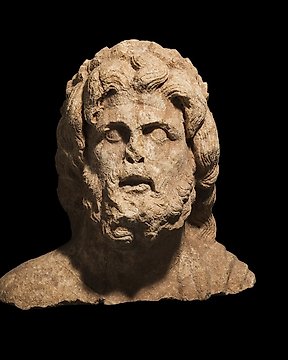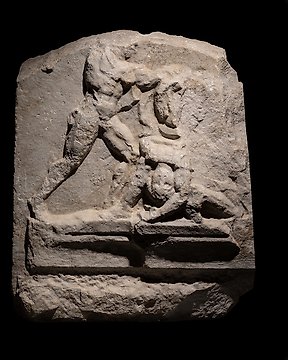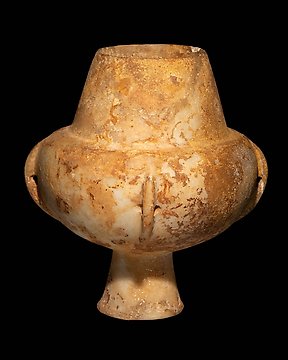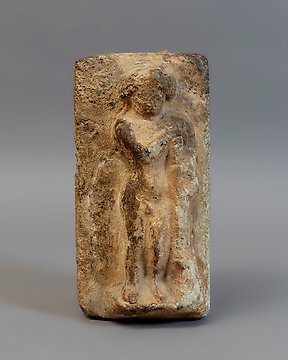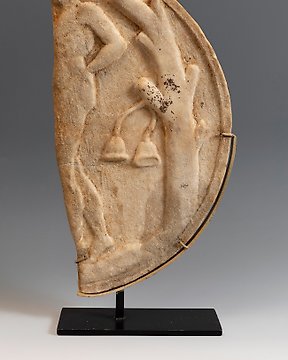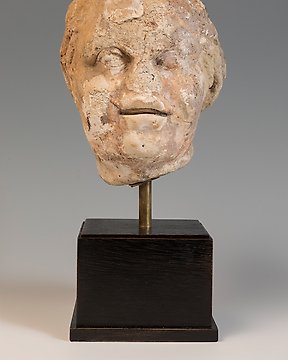Magnifique témoin du passé, envoyé avec tous les justificatifs, impeccable. Encore une fois très satisfait, un grand merci
Ver traduzidoRoma Antiga Mármore Importante torso de Ganimedes. Século 2 DC. 47 cm H. Licença de exportação espanhola e passaporte
N.º 84871143
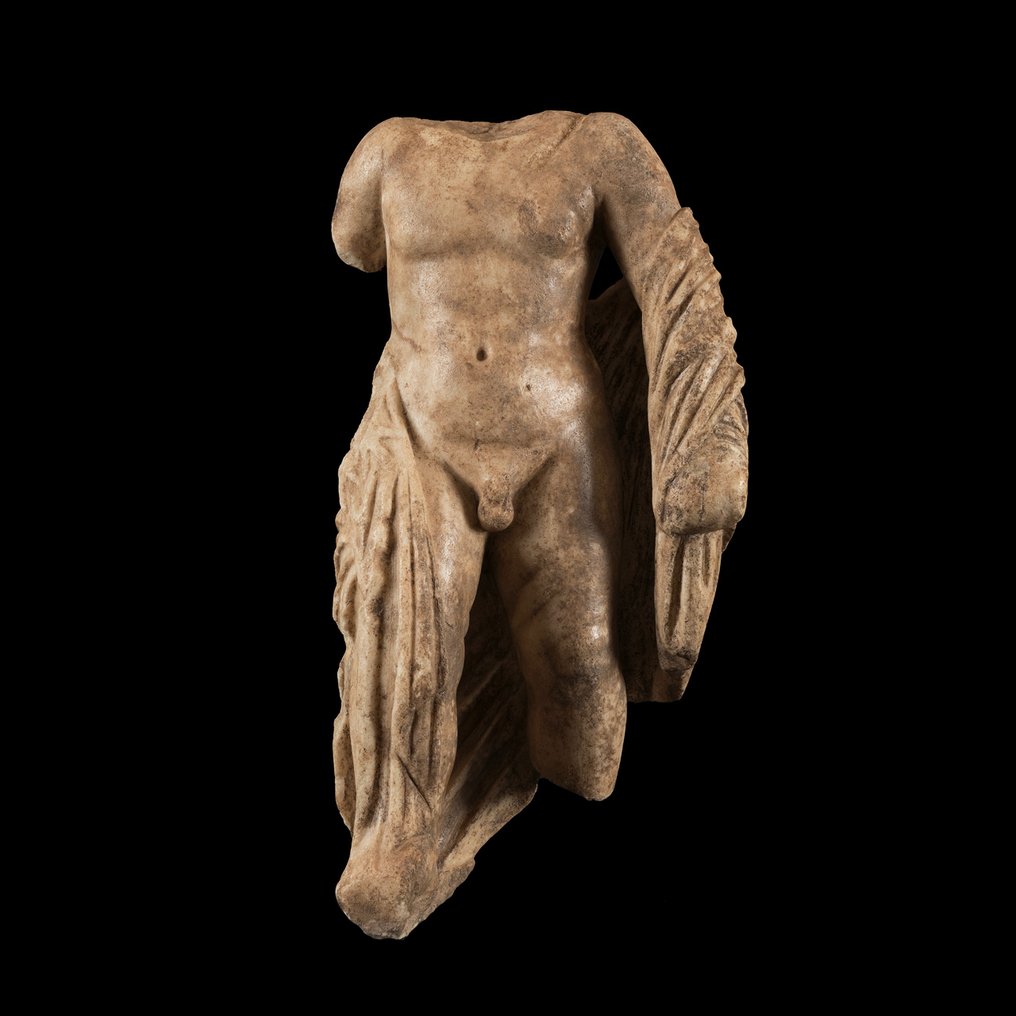
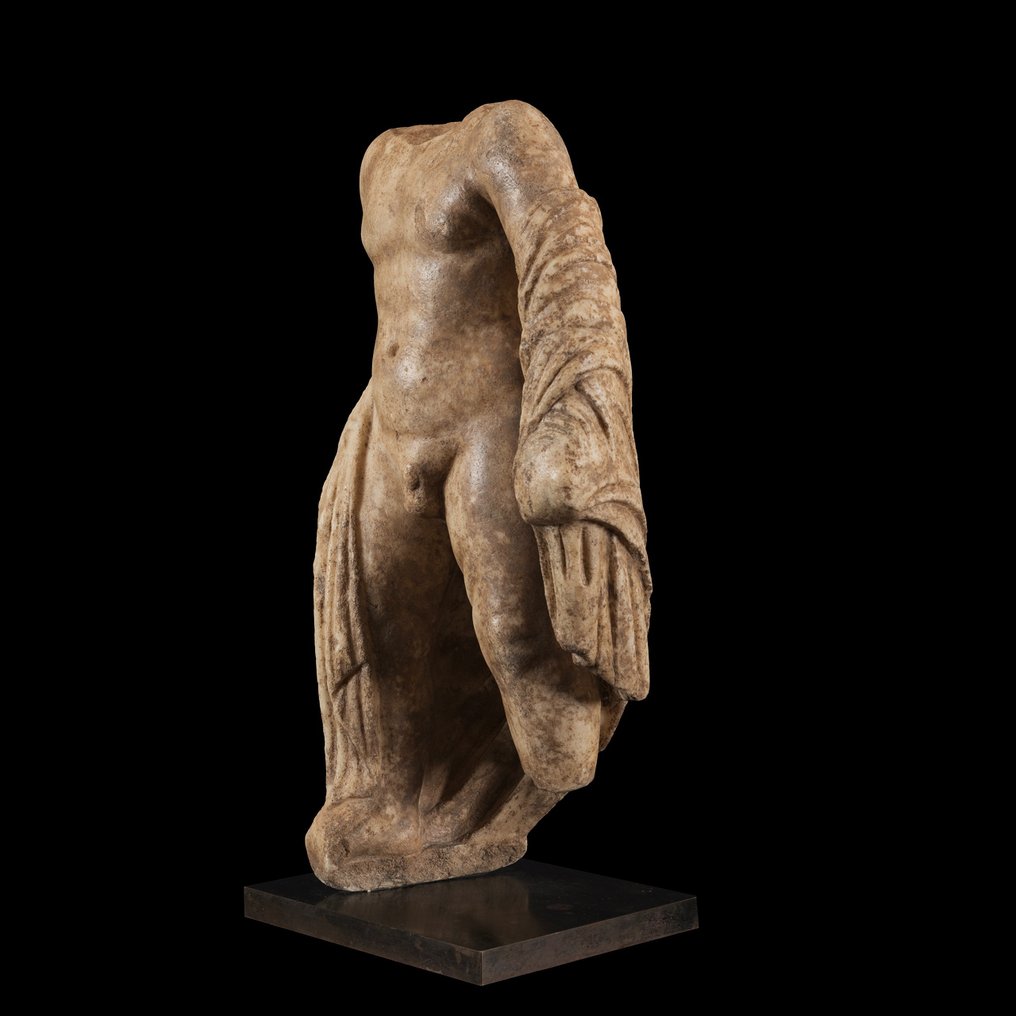

Nice Ganymede torso
- big sculpture -
CULTURE: Roman Empire
PERIOD: 2nd century AD
MATERIAL: Marble
DIMENSIONS: 47 cm height, and 50 cm heigh with stand.
PROVENANCE:
- Private collection, Mr. Firmin - Didot, 19th century.
- Auctioned at Jean Loiseau Alain Schmitz, Saint Germain en Laye, March 8, 1981, Lot 187.
- Private Collection, Marquis du G., Château de Terraube, Franica.
- Private Collection, Geneva, Switzerland .
CONDITION: IGood state of conservation, without restorations. It presents a superficial patina in reddish-brown tones of marble.
Torso belonging to a complete sculpture of the divine hero Ganymede. It is carved from a single block of marble. Possibly, given its dimensions, it would be a private sculpture, decorating a garden, although it could well be a public one.
As the lover of Zeus, the chief god of Olympus, her mythical history was often depicted by vase painters in Athens, which was well suited for all-male symposiums or formal banquets. Around 350 BC, the Athenian sculptor Leochares, who worked with Scopas on the mausoleum at Halicarnassus, modeled a bronze group of Ganymede and the eagle, an extraordinary work for its ingenious composition, which boldly ventures to the edge of the permissible by the laws of sculpture, and also by his charming treatment of the young man flying through the air. This sculpture is apparently imitated by a well-known marble group from the Vatican (fig. 1), at half natural scale. Such Hellenistic feats in defying gravity influenced the arts of the Baroque.
The attribution of this headless sculpture to Ganymede is due to the conservation on the side of his right thigh of both claws of the eagle that would be holding him to ascend to Olympus. Next to them there is a perfectly carved cavity in the shape of a rectangle, together with two slight circular holes, they are nothing more than anchor points for other parts of the sculpture, also carved in marble but a separate piece, a very common resource in classical statuary. . In this case, the eagle, which due to its anatomical complexity, if it had its wings outstretched, the artist would make this sculptural ensemble using different blocks of marble, at least one for the figure and one for the bird. The Prado Museum preserves a set in which the claws are holding the hero's waist (fig. 2), a position similar to this torso, although it would not correspond to the same composition, since it is presented on a shelf.
The nude figure is supported by the left forearm, where a mantle is wrapped around it, with accentuated folds, which passes through the lower part of the back and legs until it rests and descends through the right leg. It is worth noting the youthful appearance of the body, without developing as an adult. The detail and finesse in the sculpture is frontally correct, the back, as in most statues, is carved in a simpler way and without the same degree of polishing, a fact that indicates that it would be made to be seen from the front, located in a niche or in front of a wall.
In Greek mythology, Ganymede (fig. 3) was a divine hero from the Troas and a handsome Trojan prince. Son of King Tros, who gave his name to Troy, his mother was Callírroe. He was kidnapped by the god Zeus on Mount Ida, in Phrygia. Ganymede spent there the time of exile to which many heroes underwent in his youth, tending a flock of sheep and educating himself, together with his friends and tutors. Zeus saw him and instantly fell in love with him, and by sending an eagle or transforming himself into one, he took him to Mount Olympus, making him his lover, bedfellow, and cupbearer to the gods. Zeus later ascended Ganymede into heaven as the constellation of Aquarius (the Water Bearer), which is related to that of Aquila (the Eagle).
This myth had an important later influence, in ancient Rome the passive object of a man's homosexual desire was a catamitus, a word that evolves from the Greek Ganymede. In poetry it is a symbol of the ideally beautiful young man and of homosexual love, and related to the Trojan War it is contrasted with Helen of Troy in the role of a symbol of love for women. Zeus for the Romans is Jupiter, the main satellite of this planet was baptized with the name of Ganymede.
PARALLELS:
Fig. 1 Ganymede caught by the eagle. Roman copy of a Greek original c. 325 BC Marble. Galleria dei Candelabri, Vatican Museum. Inv. 2445.
Fig. 2 Ganymede. Roman Empire, c. 160 – 170 AD Marble. 150 cm high. Prado Museum, Madrid. E000035.
Fig. 3 Bust of Ganymede. Roman Empire, 2nd century AD. Marble. 56 cm high. Musee du Louvre, Paris. Ma535.
Notes:
- The piece includes authenticity certificate.
- The piece includes Spanish Export License.
- The seller guarantees that he acquired this piece according to all national and international laws related to the ownership of cultural property. Provenance statement seen by Catawiki.
Mais sobre o vendedor
Nice Ganymede torso
- big sculpture -
CULTURE: Roman Empire
PERIOD: 2nd century AD
MATERIAL: Marble
DIMENSIONS: 47 cm height, and 50 cm heigh with stand.
PROVENANCE:
- Private collection, Mr. Firmin - Didot, 19th century.
- Auctioned at Jean Loiseau Alain Schmitz, Saint Germain en Laye, March 8, 1981, Lot 187.
- Private Collection, Marquis du G., Château de Terraube, Franica.
- Private Collection, Geneva, Switzerland .
CONDITION: IGood state of conservation, without restorations. It presents a superficial patina in reddish-brown tones of marble.
Torso belonging to a complete sculpture of the divine hero Ganymede. It is carved from a single block of marble. Possibly, given its dimensions, it would be a private sculpture, decorating a garden, although it could well be a public one.
As the lover of Zeus, the chief god of Olympus, her mythical history was often depicted by vase painters in Athens, which was well suited for all-male symposiums or formal banquets. Around 350 BC, the Athenian sculptor Leochares, who worked with Scopas on the mausoleum at Halicarnassus, modeled a bronze group of Ganymede and the eagle, an extraordinary work for its ingenious composition, which boldly ventures to the edge of the permissible by the laws of sculpture, and also by his charming treatment of the young man flying through the air. This sculpture is apparently imitated by a well-known marble group from the Vatican (fig. 1), at half natural scale. Such Hellenistic feats in defying gravity influenced the arts of the Baroque.
The attribution of this headless sculpture to Ganymede is due to the conservation on the side of his right thigh of both claws of the eagle that would be holding him to ascend to Olympus. Next to them there is a perfectly carved cavity in the shape of a rectangle, together with two slight circular holes, they are nothing more than anchor points for other parts of the sculpture, also carved in marble but a separate piece, a very common resource in classical statuary. . In this case, the eagle, which due to its anatomical complexity, if it had its wings outstretched, the artist would make this sculptural ensemble using different blocks of marble, at least one for the figure and one for the bird. The Prado Museum preserves a set in which the claws are holding the hero's waist (fig. 2), a position similar to this torso, although it would not correspond to the same composition, since it is presented on a shelf.
The nude figure is supported by the left forearm, where a mantle is wrapped around it, with accentuated folds, which passes through the lower part of the back and legs until it rests and descends through the right leg. It is worth noting the youthful appearance of the body, without developing as an adult. The detail and finesse in the sculpture is frontally correct, the back, as in most statues, is carved in a simpler way and without the same degree of polishing, a fact that indicates that it would be made to be seen from the front, located in a niche or in front of a wall.
In Greek mythology, Ganymede (fig. 3) was a divine hero from the Troas and a handsome Trojan prince. Son of King Tros, who gave his name to Troy, his mother was Callírroe. He was kidnapped by the god Zeus on Mount Ida, in Phrygia. Ganymede spent there the time of exile to which many heroes underwent in his youth, tending a flock of sheep and educating himself, together with his friends and tutors. Zeus saw him and instantly fell in love with him, and by sending an eagle or transforming himself into one, he took him to Mount Olympus, making him his lover, bedfellow, and cupbearer to the gods. Zeus later ascended Ganymede into heaven as the constellation of Aquarius (the Water Bearer), which is related to that of Aquila (the Eagle).
This myth had an important later influence, in ancient Rome the passive object of a man's homosexual desire was a catamitus, a word that evolves from the Greek Ganymede. In poetry it is a symbol of the ideally beautiful young man and of homosexual love, and related to the Trojan War it is contrasted with Helen of Troy in the role of a symbol of love for women. Zeus for the Romans is Jupiter, the main satellite of this planet was baptized with the name of Ganymede.
PARALLELS:
Fig. 1 Ganymede caught by the eagle. Roman copy of a Greek original c. 325 BC Marble. Galleria dei Candelabri, Vatican Museum. Inv. 2445.
Fig. 2 Ganymede. Roman Empire, c. 160 – 170 AD Marble. 150 cm high. Prado Museum, Madrid. E000035.
Fig. 3 Bust of Ganymede. Roman Empire, 2nd century AD. Marble. 56 cm high. Musee du Louvre, Paris. Ma535.
Notes:
- The piece includes authenticity certificate.
- The piece includes Spanish Export License.
- The seller guarantees that he acquired this piece according to all national and international laws related to the ownership of cultural property. Provenance statement seen by Catawiki.
Mais sobre o vendedor
- 746
- 6
- 0
Thank you for the Special offer and the fast shipping of this excellent piece of art!
Ver traduzidovery good description of the object, very good price for this rare item,. Fast sending (has been at my place 2 days after buying!). Definitely would buy again.
Ver traduzidoSehr schön
Ver traduzidoAs described, perfect logistic
Ver traduzidogreat seller, everything came as should with certificate of authenticity
Ver traduzidoExceptionally well packaged, description aligned with positing received
Ver traduzidoReally precious, but without sound...
Ver traduzidoPainting well packed and rapidly sent!
Ver traduzidosempre grande rapidità e professionalità
Ver traduzidoparfait bien reçu, merci
Ver traduzidoVery satisfied with the small Greek Lekythos. As always (we have already bought several items from Bagot), the object was wrapped and sent immediately and with the greatest care.
Ver traduzidoPerfect, excellent condition, good packaging, the parcel arrived without any problems… all is perfect as usual. Thank you very much and wait for an other nice piece like this one. Gilles.
Ver traduzido+++ Top vendeur professionnel comme d'habitude
Ver traduzidoEmbora o custo de transporte esteja acima da média foi, realmente, muito bem executado e em embalagem cuidada. Expeditos e profissionais. Recomendo
Ver traduzidoSnel en correct en goed verpakt verzonden
Ver traduzidooggetto bellissimo, fedele alla descrizione, venditore affidabile
Ver traduzidoVery nice piece and fast delivery
Ver traduzidoEverything ok, top seller! Thank you again!
Ver traduzidovery beautiful and fast shipping!thank you!
Ver traduzidoExcelent, very good piece++++
Ver traduzidoVendedor increíble muy buenos he comprado muchas veces todo perfecto. Muchas gracias
Ver traduzidopas de problème ; merci beaucoup
Ver traduzidotres rapide conforme hope next +++
Ver traduzidoSehr schön! Vielen Dank!
Ver traduzido- 746
- 6
- 0
Magnifique témoin du passé, envoyé avec tous les justificatifs, impeccable. Encore une fois très satisfait, un grand merci
Ver traduzidoAviso Legal
O vendedor garante e pode provar que o objeto foi obtido legalmente. O vendedor foi informado pela Catawiki que tinha de fornecer a documentação exigida pelas leis e regulamentos do seu país de residência. O vendedor garante que tem o direito de vender/exportar este objeto. O vendedor fornecerá ao comprador toda a informação conhecida sobre a proveniência do objeto. O vendedor garante que serão ou já foram obtidas todas as autorizações necessárias. O vendedor informará imediatamente o comprador de quaisquer atrasos na obtenção de tais autorizações.
O vendedor garante e pode provar que o objeto foi obtido legalmente. O vendedor foi informado pela Catawiki que tinha de fornecer a documentação exigida pelas leis e regulamentos do seu país de residência. O vendedor garante que tem o direito de vender/exportar este objeto. O vendedor fornecerá ao comprador toda a informação conhecida sobre a proveniência do objeto. O vendedor garante que serão ou já foram obtidas todas as autorizações necessárias. O vendedor informará imediatamente o comprador de quaisquer atrasos na obtenção de tais autorizações.



